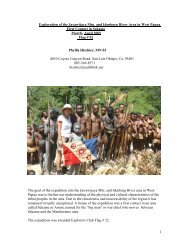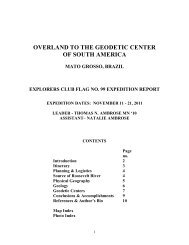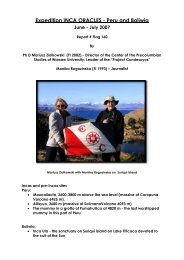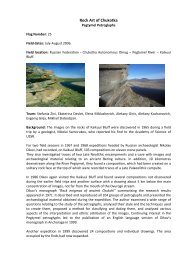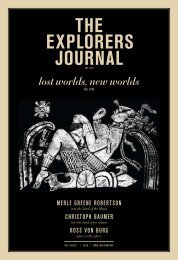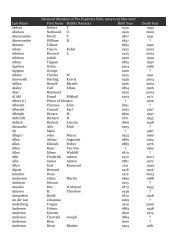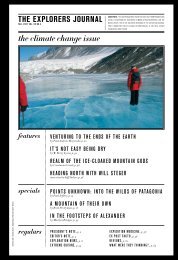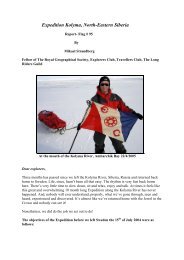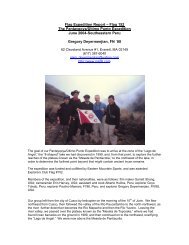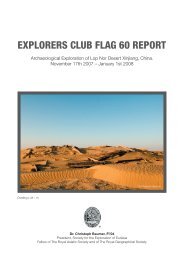the explorers journal - The Explorers Club
the explorers journal - The Explorers Club
the explorers journal - The Explorers Club
Create successful ePaper yourself
Turn your PDF publications into a flip-book with our unique Google optimized e-Paper software.
productions of time”—just as we know that those<br />
very productions both defy and mirror eternity.<br />
Some of <strong>the</strong> images reproduced here depict<br />
vistas whose photons started <strong>the</strong>ir long journey<br />
toward us well before Homo sapiens arose on<br />
this miniscule mote of oxygenated, irrigated Earth.<br />
Some predate <strong>the</strong> very formation of <strong>the</strong> Earth itself,<br />
and <strong>the</strong> star about which it orbits, eventually to be<br />
received by us—products of a garden yet unformed<br />
at <strong>the</strong>ir journey’s start. It is slow glass indeed.<br />
And <strong>the</strong>re we end, at <strong>the</strong> beginning, a scene shimmering<br />
through deep time and interstellar dust. <strong>The</strong><br />
interacting galaxies of an early universe, glowworms<br />
of different colors, glint at <strong>the</strong> bottom of deep wells,<br />
reflected in perfectly polished concave mirrors encased<br />
within scrupulously machined tubes. This still<br />
water serves to ga<strong>the</strong>r far-traveled interstellar photons<br />
from time’s edge. <strong>The</strong> enlarging mirrors of our<br />
telescopes comprise material forged at <strong>the</strong> centers<br />
of <strong>the</strong> same generation of stars <strong>the</strong>y now record.<br />
Our gaze is irrevocably bound to <strong>the</strong> very fibers,<br />
tendons, muscles, synapses, and cognitive glints<br />
that would be impossible without <strong>the</strong> heavier<br />
elements, alien to <strong>the</strong> early universe, smelted by<br />
giant suns in time’s earliest epochs. And we—our<br />
physical selves and our earliest incarnations all<br />
<strong>the</strong> way back to <strong>the</strong> first bacterium—what did we<br />
do Rooted in temporality, we still managed to<br />
race ahead, like dolphins in a storm surge, intent<br />
on exploding out of <strong>the</strong> wave to intercept rays of<br />
archival starlight—fecund rays, alive with <strong>the</strong> DNA<br />
of a universe.<br />
b i o g r a p h y<br />
A Fellow of <strong>The</strong> <strong>Explorers</strong> <strong>Club</strong>, Michael Benson<br />
is a New York-based writer and filmmaker. He is<br />
<strong>the</strong> author of Beyond: Visions of <strong>the</strong> Interplanetary<br />
Probes and <strong>the</strong> recently released Far Out: A<br />
Space-Time Chronicle.<br />
D e e p - T i m e E x p o s u r e<br />
<strong>The</strong> Hubble Ultra Deep Field is <strong>the</strong> deepest picture ever taken of <strong>the</strong><br />
universe in visible light; <strong>the</strong> image represents a cumulative exposure<br />
time of more than 11 days. Among <strong>the</strong> 10,000 galaxies visible here<br />
are those that formed within some 800 million years of <strong>the</strong> Big Bang.<br />
<strong>The</strong>se earliest galaxies can be seen as small red forms, some appearing<br />
as mere dots. Image courtesy HST/NASA/ESA.<br />
46



